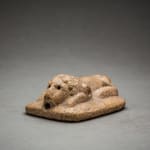Sumerian Stone Seal of a Recumbant Lion, 2500 BCE - 1500 BCE
Stone
11.4 x 4.6 cm
4 1/2 x 1 3/4 in
4 1/2 x 1 3/4 in
LO.1374
Further images
The Sumerian civilization was an extremely advanced and complex society situated in modern day Iraq. Lasting for some four thousand years, the Sumerians were among the first cultures to develop...
The Sumerian civilization was an extremely advanced and complex society situated in modern day Iraq. Lasting for some four thousand years, the Sumerians were among the first cultures to develop most of what we now take for granted, from complex economies to advanced record keeping, literature, international trade and recorded mythologies. Thanks to the Sumerian habit of recording everything on clay tablets using cuneiform – one of the first complex writing systems – we can infer a great deal about their society. We know that Sumer was characterized by various city-states, running in competition with one another for wealth and conquest, while sharing similar characteristics and material goods. They used slave labor, based around large temples and palaces, and were keen to form alliances and thus push out the boundaries of their nation into Central Asia and Turkey. Their trade networks were extensive, and colonies of Sumerian peoples have been identified all across the region. Rule was by kingship; rulers varied considerable in their methods although extreme cruelty and martial law (such as that exercised under Eannatum of Lagash) was the exception rather than the rule. Temples were the mainstay of local economies. It was here that produce was brought as tax, legal proceedings carried out and deals were struck. Records of this period are almost exclusively written by scribes who lived within the temple walls and worked under the auspices of the administrators, who were themselves under the authority of the priests.







